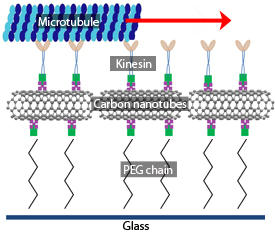

06/30/2014

Reproduced, with permission, from Ref. 1 © 2014 American Chemical Society
Miniature chemical reactors, known as lab-on-a-chip devices, are increasingly being used to analyse biological samples. Unfortunately, the bulky pumps and batteries needed to operate such devices limit their further miniaturization and prevent them from being directly implanted into the body for monitoring applications.
Winfried Teizer from the AIMR at Tohoku University and colleagues have now developed a much smaller system that uses a biological motor to transport cargo along a track made of carbon nanotubes (see image)1.
Kinesin-1 is a natural motor protein that is powered by adenosine triphosphate (ATP), the principal energy-carrying molecule in cells. Kinesin uses this energy to carry cell components along hollow cylinders called microtubules, which consist of polymers of tubulin proteins and are typically 25 nanometers wide and several micrometers long. Teizer’s team reversed this arrangement by anchoring kinesin proteins along a track, and then using them to propel microtubules like a conveyor belt.
The researchers coated a glass plate with aminosilane molecules and attached them to polyethylene glycol chains tipped with a biological compound called biotin. They then added multiwalled carbon nanotubes (MWCNTs) that were peppered with streptavidin, a protein that binds strongly to biotin. The streptavidin molecules covered the nanotube surface with a density of around 35,000 per square micrometer.
The researchers used electrodes that were crenellated into a saw-tooth pattern to subject the nanotubes to an electric field. This process, called dielectrophoresis, neatly aligned the nanotubes so that they formed tracks between the electrodes.
The researchers covered the nanotubes with kinesin bearing a biotin linker, and then added microtubules that had been labeled with a fluorescent dye called rhodamine. As the kinesin molecules consumed ATP, they forced the microtubules to glide along the track at an average speed of around 150 nanometers per second.
This is slower than kinesin’s usual velocity of about 800 nanometers per second. The researchers suggest this may be because their kinesin was engineered to be shorter than natural kinesin, limiting its ability to twist as it propels the microtubules.
“We have demonstrated that gliding on MWCNTs is possible, but we don’t know if the microtubule shuttle can transit between tracks, which would allow the possibility of a complete circuit based on MWCNTs,” says Teizer. “We are now investigating microtubule displacement between MWCNT segments.”
The researchers hope that their microtubule conveyor belt could eventually be loaded with cargos such as viruses, drugs, proteins or nanoparticles, which would be useful for a variety of biosensing applications.
Sikora, A., Ramoń-Azcoń, J., Kim, K., Reaves, K., Nakazawa, H., Umetsu, M., Kumagai, H., Adschiri, T., Shiku, H. & Matsue, T. et al. Molecular motor-powered shuttles along multi-walled carbon nanotube tracks. Nano Letters 14, 876–881 (2014). | article
This research highlight has been approved by the authors of the original article and all information and data contained within has been provided by said authors.